Business Groups Want State To Reopen
Pushing Evers to act within two weeks. Scientists say it's too soon.

Wisconsin Manufacturers and Commerce. Photo by Riley Vetterkind / Wisconsin Center for Investigative Journalism.
The state’s largest business group and more than four dozen trade groups and local chambers of commerce are urging Gov. Tony Evers to lift his COVID-19 pandemic-related Safer-at-Home order and begin to reopen the state within two weeks.
But researchers who are studying the spread of COVID-19 warn that following such a calendar could have devastating results. And one business organization, whose members helped persuade Evers to institute the state’s Safer-at-Home policy two weeks ago, did not sign on to the letter, as a spokesman warned that any plan for coming out of the current shutdown should rest first on public health considerations.
At a state Department of Health Services (DHS) media briefing Friday, Evers expressed sympathy with businesses eager to get back into operation but said he would focus on public health and safety.
“I appreciate their concern,” he said. “Nobody wants to open up the state any more than I do. But we have to make sure that the state is ready to be opened up.”
The state has not yet seen its peak caseload of people infected with the novel coronavirus responsible for the pandemic, the governor warned.
“So we are working hard on those plans [for] when we begin to [reverse] some of the restrictions we have put in place,” Evers said. “But we will follow science, and right now, the curve is not bent, and we need to make sure that we’re headed in the right direction. I think whether you’re a business leader or you’re not a business leader — you’re just Tony Evers sitting at home — the last thing you want is to have a resurgence because you, quote, unquote, ‘reopened’ too soon.”
Letter from WMC
Evers commented in response to a letter that Wisconsin Manufacturers & Commerce posted on its website calling for the governor to reopen the state starting April 24. The letter was signed by 19 other trade associations and 33 local chambers of commerce. WMC announced on Friday that it had sent the letter and posted it to the organization’s website.
While it commends the Evers administration’s “attention to public health” in handling the COVID-19 pandemic in the state, the letter laments the “significant public cost” from the Safer-at-Home order.
“We have broken records for unemployment claims, with nearly 300,000 new claims in March alone. Foot traffic at retail businesses is down more than 50%, and is down more than 75% at restaurants. Our state unemployment rate is now estimated to be 13.4%, which is higher than any time in recorded history — and it is expected to climb higher.”
It calls on the state “to bring certainty to workers and businesses alike by setting a firm date to begin the process of reopening our economy on April 24 – the end date for the Safer at Home order.”
While the order currently lists that as the last date, Health Emergency that Evers declared March 12 can last up to 60 days without legislative approval under the law that enabled it, and could be extended further with legislative approval.
Businesses could resume and continue to require social distancing in the workplace, it states, and reopening businesses might “involve a more targeted geographic approach which recognizes that different parts of the state are having a very different experience in terms of transmission and infection rates.” The phrase alludes to the disproportionate share of the state’s COVID-19 infections in Milwaukee County, although the letter never refers to those “different parts” by name.
Among the organizations signing the letter, one name in particular was missing: the Metropolitan Milwaukee Association of Commerce. The MMAC played a key role in persuading Evers in late March to institute the statewide Safer at Home order.
“WMC did not share a draft of their letter with us in advance of its release, and naturally we would not sign on to a letter we had not seen,” MMAC’s vice president for government affairs and public policy, Steve Baas, tells the Wisconsin Examiner.
And while the MMAC along with WMC is “acutely sensitive to the economic impact of the current state shutdown and eager for the economy to restart,” it had additional concerns.
“We all share the goal of opening up the economy again,” Baas says. “However, the ‘start date’ for that reopening cannot be chosen arbitrarily. It has to be structured around the actual public health situation.”
The MMAC is “working with legislators, the administration, businesses, and health care leaders to develop a workable plan for restart of the economy that is tied to and benchmarked by public health outcomes,” says Baas. “The last thing any of us want is to act prematurely and risk a new round of infection that will necessitate another complete shutdown.”
Data and forecasts
Assessing the public health context for any decision is complicated. One measure that researchers are using to understand the spread of the disease involves examining people’s movement using cell phone data.
At the University of Wisconsin-Madison, the Geospatial Data Science Lab in the geography department hosts a daily updated map that uses geolocation data from smartphones to track people’s movement. The data, collected by outside businesses, is aggregated to avoid compromising individual phone users’ privacy.
Song Gao, a geography professor, has developed a web portal that tracks changes in the data in order to measure how much people are — or are not — moving around through their communities and beyond. It’s a way of seeing, says Gao, “how people in different counties and different states react to social distancing guidelines and Safer-at-Home orders.”
A county’s movement data for each day is compared with an average baseline number for the same county for weekdays between Feb. 17 and March 7 of 2020 to gauge how much less people are roaming compared to then. “Reduced mobility can be a proxy for [measuring adherence to] the social or physical distancing guidelines,” Gao explains. The portal can display past days’ data with a lag of about three days.

A University of Wisconsin-Madison Geospatial Data Science Lab web portal tracks changes in mobility across the country using aggregated smartphone data. This graph shows changes in mobility in Wisconsin since March 1. Screenshot from Mapping Mobility Changes in Response to COVID-19 by GeoDS Lab @ UW-Madison.
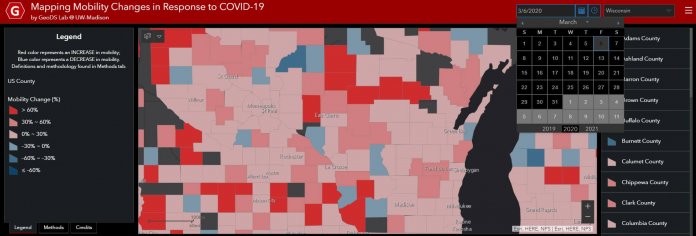
A University of Wisconsin-Madison Geospatial Data Science Lab web portal tracks changes in mobility across the country using aggregated smartphone data. This map shows changes in mobility county by county in Wisconsin on March 6. The red and pink areas indicate greater movement on that date compared with the baseline in late February. Screenshot from Mapping Mobility Changes in Response to COVID-19 by GeoDS Lab @ UW-Madison.
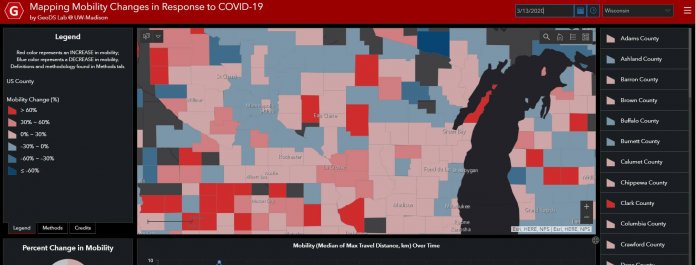
This map shows changes in mobility county by county in Wisconsin on March 13. The red and pink areas indicate greater movement on that date compared with the baseline in late February. Screenshot from Mapping Mobility Changes in Response to COVID-19 by GeoDS Lab @ UW-Madison.
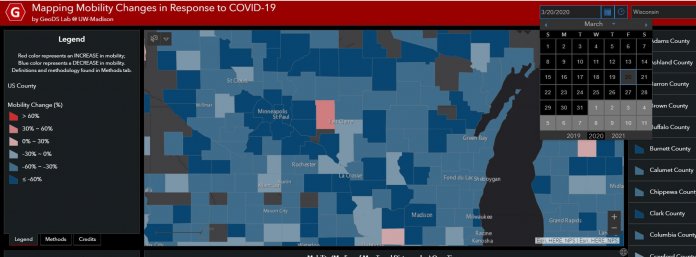
This map shows changes in mobility county by county in Wisconsin on March 20. The red and pink areas indicate greater movement on that date compared with the baseline in late February. Screenshot from Mapping Mobility Changes in Response to COVID-19 by GeoDS Lab @ UW-Madison.
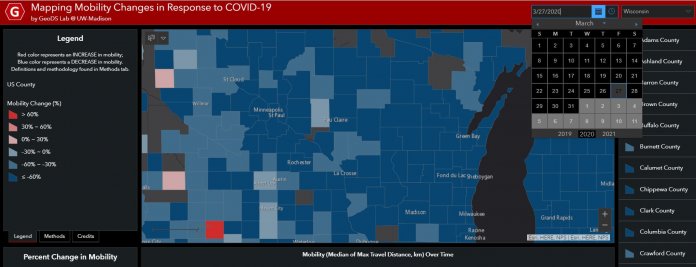
This map shows changes in mobility county by county in Wisconsin on March 27. The red and pink areas indicate greater movement on that date compared with the baseline in late February. Screenshot from Mapping Mobility Changes in Response to COVID-19 by GeoDS Lab @ UW-Madison.
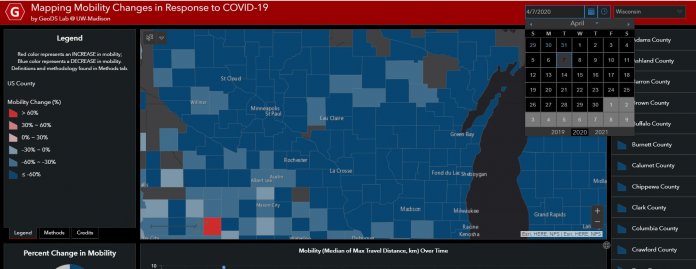
This map shows changes in mobility county by county in Wisconsin on April 7, the most recent date available as of April 10. The red and pink areas indicate greater movement on that date compared with the baseline in late February. Screenshot from Mapping Mobility Changes in Response to COVID-19 by GeoDS Lab @ UW-Madison.
Comparing the mobility pattern with the current trajectory of COVID-19 infections suggests that reducing movement has “played a very positive role in reducing the growth rate of the disease,” says Gao, but he cautions that “the mobility pattern itself cannot tell the full story.”
Another source of data are projections produced by the University of Washington Institute for Health Metrics and Evaluation (IHME). Using modeling techniques drawing on state data, the projection aims to show demand for hospital services nationally and in each state.
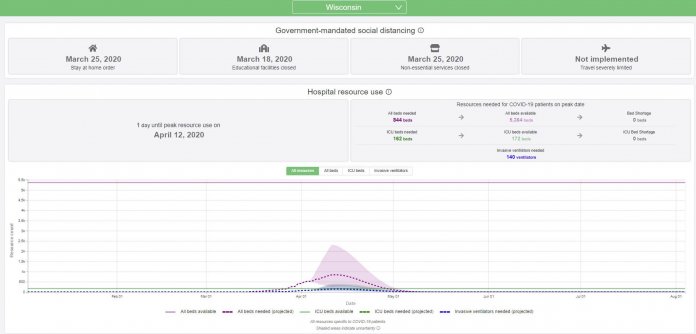
The University of Washington Institute for Health Metrics and Evaluation (IHME) model uses state data to project COVID-19 deaths and demand for hospital services nationally and in each state. This image shows the projection for Wisconsin hospital resource use as of Friday, April 10. Screenshot from University of Washington IMHE COVID-19 Projections.
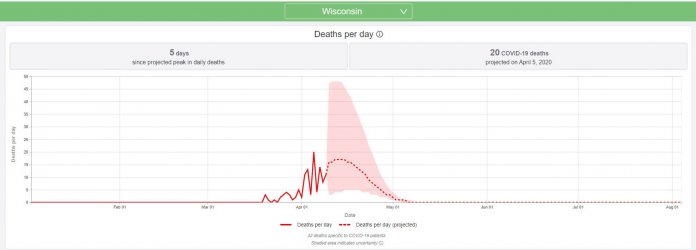
This image shows the The University of Washington Institute for Health Metrics and Evaluation (IHME) projection for Wisconsin deaths per day as of Friday, April 10. Screenshot from University of Washington IMHE COVID-19 Projections.
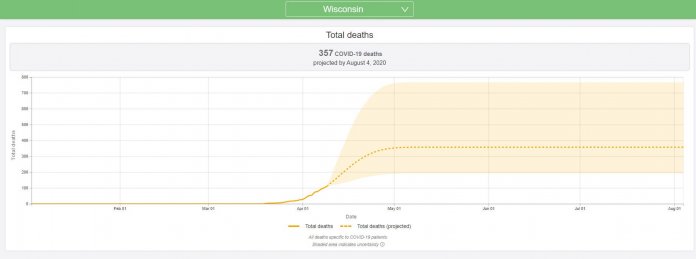
This image shows the The University of Washington Institute for Health Metrics and Evaluation (IHME) projection for Wisconsin deaths through the end of July as of Friday, April 10. Screenshot from University of Washington IMHE COVID-19 Projections.
Nationally, the projection forecasts that demand for hospital resources will exceed capacity, while state by state the projections differ. The IHME projections for Wisconsin on March 31 forecast a shortage of more than 200 intensive care unit beds, a daily peak of 25 deaths in late April, and more than 900 deaths by August 5. Those have since gotten more hopeful, suggesting that deaths in the state might have peaked at 20 on April 4, that hospital resource use could peak as soon as Sunday, April 12, and that state deaths might be below 400 by Aug. 4.
Uncertainty
But there are many limitations to those projections, says Dr. Theo Vos, a senior faculty member at IHME.
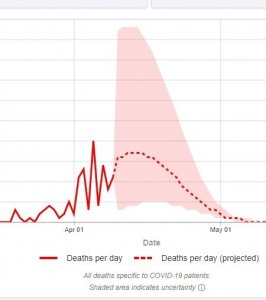
The University of Washington Institute for Health Metrics and Evaluation (IHME) projections include a wide band of uncertainty, as shown by the shaded areas in the images the model generates. Screenshot from University of Washington IMHE COVID-19 Projections.
The primary one is the broad measure of uncertainty — shown as shaded areas on the graphs generated by the IMHE model. What is most clear, Vos tells the Wisconsin Examiner, is that “Wisconsin is still very early on in the epidemic, and it’s still on a rising slope.”
The day-to-day changes in the projections since the end of March reflect new information, rather than changes in how the state has responded.
“Every day when we get new data, the model is updated and it reacts, having more information to work with,” Vos says. “Also, the shape of the curve is influenced by increasing amounts of knowledge that we have from jurisdictions and countries that have gone over the top already.”
And built into the model is the assumption that “full social distancing measures” continue through the month of May.
Asked Friday about the prospect of starting to wind down Wisconsin’s current shutdown starting April 24, Vos said: “We are not projecting an end to the first wave of the epidemic in Wisconsin until the first week of May. It is not clear what early relaxing of the social distancing measures would do. We are working on building that into our models but that will take at least another week.”
Brian Yandell, a statistician and interim director of the American Family Insurance Data Science Institute at UW-Madison, which collaborates with the Geospatial Data Science Lab, cautions that he’s not a public health scientist, but he has studied the statistical models being used to understand the spread of the disease.
The physical distancing “seems to be having an effect,” he says — one sign of which is that it is taking nearly eight days for the number of infections to double.
The number of confirmed cases “is not the number of actual cases,” Yandell observes. “So early on when we didn’t have [widespread] testing, the confirmed cases were a drastic underestimate.”
Expanding testing
As of Saturday April 11, DHS reported 3,213 COVID-19 infections in Wisconsin, with 137 deaths.
Vos says that to safely relax a shutdown, policymakers need to be prepared “for active case finding and contact tracing.” Enough public health workers must be trained and deployed, along with health workers who can test “anyone who comes to them with early symptoms of what could be COVID-19 infection.” Tests need to be able to be quickly turned around “to allow isolation of any positive cases and their potential contacts.”
And when they become available and have been appropriately validated, antibody tests that can uncover the real degree of exposure in the broader community, including among people who never had serious symptoms, can provide “an additional warning system… for signs of increased spread of the virus in the community,” Vos says.
At Friday’s media briefing, Dr. Ryan Westergaard, chief medical officer for the DHS bureau of communicable disease, and Andrea Palm, DHS secretary-designate, said expanding testing is already underway, along with efforts to expand the DHS workforce and recruit more people to do contract tracing.
And in the longer term, Palm said, one of the state’s task forces on COVID-19 is examining how to expand the state testing capacity further as new tests become available. “We believe widespread testing is an important way to be able to do less restrictive measures,” Palm told the Wisconsin Examiner.
At the same time, said Westergaard, as more testing becomes available, “the demand is going to be so extraordinary that it could be weeks or months” before the supply is adequate to meet it. And even then, it isn’t enough on its own.
“Widespread testing is important because without it we don’t have visibility on where the infection is,” he said. “But it’s not sufficient. Just testing is not an infection control strategy.”
Once more testing is available, resources to follow up are imperative.
“We have to do local public health infrastructure,” Westergaard continued. “We need massive investments in local communities and their health departments to be able to do the contact tracing in a sustainable way, because until we get a vaccine we’re going to be having to do this — we’re going to have to be doing contact tracing, and community outreach, and going to people’s homes, and making sure hc facilities have PPE — we’re going to be having to do this for a long time, frankly. It might be a year or more or two years before we have tools in place to eradicate or stamp out the infection altogether.”
Reprinted with permission of Wisconsin Examiner.
More about the Coronavirus Pandemic
- Governors Tony Evers, JB Pritzker, Tim Walz, and Gretchen Whitmer Issue a Joint Statement Concerning Reports that Donald Trump Gave Russian Dictator Putin American COVID-19 Supplies - Gov. Tony Evers - Oct 11th, 2024
- MHD Release: Milwaukee Health Department Launches COVID-19 Wastewater Testing Dashboard - City of Milwaukee Health Department - Jan 23rd, 2024
- Milwaukee County Announces New Policies Related to COVID-19 Pandemic - County Executive David Crowley - May 9th, 2023
- DHS Details End of Emergency COVID-19 Response - Wisconsin Department of Health Services - Apr 26th, 2023
- Milwaukee Health Department Announces Upcoming Changes to COVID-19 Services - City of Milwaukee Health Department - Mar 17th, 2023
- Fitzgerald Applauds Passage of COVID-19 Origin Act - U.S. Rep. Scott Fitzgerald - Mar 10th, 2023
- DHS Expands Free COVID-19 Testing Program - Wisconsin Department of Health Services - Feb 10th, 2023
- MKE County: COVID-19 Hospitalizations Rising - Graham Kilmer - Jan 16th, 2023
- Not Enough Getting Bivalent Booster Shots, State Health Officials Warn - Gaby Vinick - Dec 26th, 2022
- Nearly All Wisconsinites Age 6 Months and Older Now Eligible for Updated COVID-19 Vaccine - Wisconsin Department of Health Services - Dec 15th, 2022
Read more about Coronavirus Pandemic here





















This letter seems highly irresponsible to me. Or perhaps it is just cynical: they expect Evers to reject this proposal, allowing them to attack him for whatever problems emerge.
Evers doesn’t have the ability to reopen the economy. The economy will not return to the way it was without a solution to the virus (vaccine, herd immunity, MASSIVE testing, or effective treatment). Without a solution, MANY parts of the economy cannot return.
Who will eat in restaurants? Who will go to a movie, concert, or sporting event? Who would want to attend State Fair or fly on an airplane? How does one even get a haircut without a solution to the virus? Even people in their 20s are dying from this pathogen.
I wish I were shocked by the letter. When a group like WMC expresses a recognition of the need for all manner of scaled up testing, contact tracing and a willingness to fund all of that, then such a proposal could be taken seriously. What are the metrics, who will actively check the data? When will there be enough tests and testing equipment to quickly screen people across the state? There will be a cost to implement restarting the economy. Business is incentivized to make that happen. Business has a responsibility to recognize the safe steps to make it happen and business must shoulder at least some of the cost. Simply lobbing a date across the governor’s wall doesn’t suggest a comprehensive understanding of what lies ahead and the variables that are sure to arise. We all want “normal.” The next steps will be successful if parties, trade groups and citizens work together, don’t behave like spoiled, impatient entities and rely on the guidance of science and facts. Not on an arbitrary date.
did I miss the part that the Governor does not have the authority to extend the quarantine
with out action from the legislature?
Just heard a story reported on BBC radio. South Korea which has the lowest reported virus cases in an industrialized nation is now stating they have over 150 cases of COVID 19 in people for a second time. Antibodies may not occur in individuals to fight this disease?